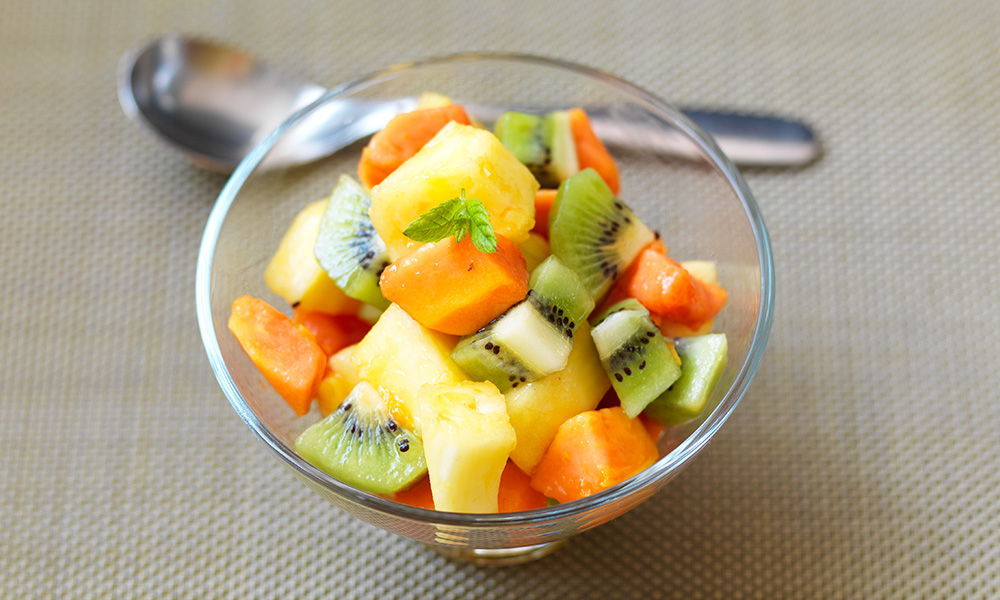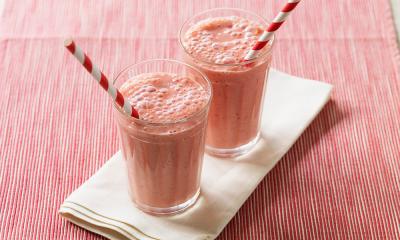
Everyone should be eating more fruit and vegetables. You're probably aware of the five-a-day minimum target, and this is equally important if you’re living with diabetes or if you’re not.
This is because fruit and vegetables are associated with lower risk of heart disease and certain types of cancers. They also have a good mix of soluble and insoluble fibre which is good for your bowels and general health and they provide a range of vitamins and minerals.
They can also help people living with diabetes manage their blood pressure and blood cholesterol.
In this guide:
- How much sugar is in fruit and vegetables?
- Juices and smoothies
- Portion sizes
- Lesser-known fruit and vegetables
- How to increase your fruit and veg intake
- Recipe ideas
How much sugar is in fruit and vegetables?
You might think that the sugar content of fruit, and some vegetables, means that you can’t eat them. But the sugar in whole fruit and veg does not count towards free sugars, so it is not this type of sugar we need to cut down on. This is different to the free sugar in drinks, chocolate, cakes and biscuits, as well as in fruit and vegetable juices and honey.
A portion of fruit, such as a medium-sized apple, generally contains about 15 to 20g carbs as well as other important nutrients. And many fruits and veg have a low-to-medium glycaemic index (GI), which tells us whether a food raises blood glucose levels quickly, moderately or slowly.
It is better to reduce your intake of high-sugar, high-fat snacks and drinks such as chocolate, fizzy drinks, cakes and crisps, rather than whole fruit or veg when trying to restrict your carb intake to help manage your blood glucose levels and overall health.
For people who follow a low-carb diet, it is important to identify the sources of carbs that are not healthy and cut those down first.
It is unlikely that you need to reduce your fruit or veg intake but you could keep a food diary to check how often and how much fruit you are eating.
Some people eat fruit infrequently, but have larger portions when they do eat them, which can mean the carbohydrate portion in one sitting is quite high. It is easy to consume a lot of dried fruit, grapes and tropical fruits in one go, for example, and this can have a bigger impact on blood glucose levels.
If you consider a serving of dried fruit is one tablespoon, or 30g, and has as much as 20g carbs, you can see how easily this happens.
Being mindful of your serving sizes can help too – a large banana counts for one and half portions of fruit and contains about 30g carbs. But most people need to cut down on foods with free sugars and refined carbs rather than whole fruit – a large banana is still better for your long-term health than a standard slice of cake, which contains about 25g carbohydrate.
Remember to spread your fruit intake throughout the day so you are not eating a lot of carbohydrate all in one go, which could affect blood glucose levels after eating.
Why do I need to be careful about fruit and vegetable juices and smoothies?

We’ve mentioned juices and smoothies and these are something that, ideally, need to be avoided or at least cut down on.
This is because fruit and vegetable juice and smoothies have most of the roughage removed or already broken down, so the sugar from the fruit or vegetable becomes free sugars and the fibre is much easier to digest. This makes it is very easy to drink large quantities in a short space of time – and ultimately this means extra calories and carbohydrate.
Having less intact fibre means fruit juices and smoothies are not as beneficial to the body compared to whole fruits.
A serving – 150ml (and most people’s glasses at home will contain more than this) – provides about 15g carbs which counts towards free sugar, so you can see how easily it is to take in a lot of carbohydrate and free sugar without really noticing.
What’s in a portion of fruit and vegetables?
As a guide, a portion of fresh fruit and veg is 80g - roughly what fits into the palm of an adult hand. Public Health England suggest the following as a guide:
Small-sized fresh fruit
One portion is two or more small fruit, for example two plums, two satsumas, two kiwi fruit, three apricots, six lychees, seven strawberries or 14 cherries.
Medium-sized fresh fruit
One portion is one piece of fruit, such as one apple, banana, pear, orange or nectarine. Why not mix things up and try Sharon fruit? Eat it like a peach when firm, or blend soft ones with unsweetened yoghurt.
Large fresh fruit
One portion is half a grapefruit, one slice of papaya, one slice of melon (5cm slice), one large slice of pineapple or two slices of mango (5cm slices). Papaya, or pawpaw, is a tropical fruit shaped like a pear. When ripe, its skin is a deep yellow or orange with sweet and fragrant flesh, similar to a peach. Add to a fruit salad or simply slice and enjoy.
Dried fruit
A portion of dried fruit is around 30g. This is about one heaped tablespoon of raisins, currants or sultanas, one tablespoon of mixed fruit, two figs, three prunes or one handful of dried banana chips.
Tinned fruit in natural juice
One portion is roughly the same quantity of fruit that you would eat for a fresh portion, such as two pear or peach halves, six apricot halves or eight segments of tinned grapefruit.
Vegetables
One portion is:
- 2 broccoli spears, 2 heaped tablespoons of cooked spinach, or 4 heaped tablespoons of cooked kale, spring greens or green beans
- 3 heaped tablespoons of cooked carrots, peas or sweetcorn
- 8 cooked cauliflower florets
- 2 large handful of salad leaves
- 3 heaped tablespoons of beans or pulses
Lesser-known fruit and vegetables
Meal times can be a fantastic opportunity to pack in more vegetables. Add more variety to your diet by choosing different vegetables. There is huge variety of lesser known veg that is just as good for you:
- Cavolo nero, or black cabbage, is part of the brassica family. Try it in soups and salads, or with meat and fish.
- Fennel is bulb-like in shape and has a strong aniseed flavour, and crisp texture. Eat it raw in salads, or cook it to tone down the flavour.
- Broccoflower is a cross between green cauliflower and Romanesco broccoli, which stands out for its spiky, green head. It tastes sweeter than broccoli or cauliflower, but you can cook it in the same way.
- Samphire has vibrant green stalks similar to baby asparagus. It has a crisp texture and tastes of the sea. Try it with seafood dishes. Boil or steam for a few minutes before serving.
- Kohlrabi is a bulbous, pale green brassica. It has a mild and sweet flavour, and crispy texture. Try roasting, steaming or stir-frying it. Or try it sliced up and added to salads – blanch the slices in boiling water first.
- Daikon is a mild, white radish, which is shaped like a carrot, and is popular in Japanese, Chinese, and Indian cuisine. Daikon can be eaten raw or cooked, and will add a peppery kick to salads and stir-fries.
How can I increase my fruit and veg intake?
Variety is important as different coloured fruit and veg contain their own mixture of vitamins and minerals, so feel free to make changes and choose as many different types as possible. Go for whatever is in season to help keep costs down, too.
Try these 10 ways of increasing your intake which are practical and also good for your health:
- Apples, clementines, bananas, rhubarb, broccoli and cabbage are good sources of vitamin C, which is good for boosting your immune system and wound healing.
- Dried raisins are a source of iron, which is needed to make the oxygen carrying part of your blood.
- Rhubarb contains calcium, which is needed for bone formation.
- Look out for kids-sized apples and ‘easy peeling’ clementines in shops and add them into your children’s lunch boxes.
- Cooking apples taste great when baked with a little cinnamon and nutmeg served with unsweetened Greek yoghurt. You could also chop and stew them with a little water and raisins for a healthy desert ready to hand when you fancy something sweet.
- Bananas can be baked or frozen for an hour or two and then taken out to be mashed into a healthy take on ice cream.
- Veg like parsnips, beetroot and carrot are great for making into crisps.
- The portion of tinned and frozen fruit and vegetables is the same quantity as you would eat for a fresh portion.
- Double check the label for tinned fruit and veg, swap fruits in syrup to those in juice to reduce your intake of free sugars, and opt for vegetables in water with no added salt or sugar.
- If fruit juice is your preferred treatment for hypos, it comes in handy sized cartons which are portable. But try not to drink it on other occasions.
5-a-day: practical ways to reach the target.
For breakfast:
- Adding sliced banana to your cereal for breakfast and remember to reduce your usual amount of cereal to make room for the fruit
- Adding mushrooms and tomatoes with your cooked breakfast
- A fruit salad topped with no added sugar yoghurt.
For lunch: Have a healthy side salad, instead of crisps, with a sandwich and replace snacks with fruits and veg, for example, raisins and sultanas, fruit salads, raw vegetables, vegetable sticks, frozen berries.
For evening meals: Dish out the vegetables first like carrots, aubergines, broccoli, cabbages etc, and let that form the biggest part of the plate and add more vegetables to your casseroles, stews, soups etc.
Top Tip: Fruit and vegetables are better eaten raw as some nutrients are lost through cooking. Try steaming, poaching or microwaving rather than boiling in a lot of water if you prefer them cooked and add some spices and herbs if you find vegetables bland.
Try these recipes
Sticking to a healthy, balanced diet can sometimes seem like a slog. You might find yourself stuck in a rut, recycling the same few recipes. So, for something new, try these tasty recipes that are packed full of veggies.
A gluten-free dish of steamed salmon served over bed of ratatouille.
This gorgeous gluten-free pizza is a great idea for people with or without coeliac disease, and healthier than a takeaway version.
A nutritious, flavoursome soup that's quick and simple to make. Vary the vegetables according to your personal tastes.
This makes an excellent packed lunch option - with all the Mediterranean flavours it's a nice alternative to sandwiches.
A delicious vegetarian alternative to meat kebabs. With thanks to celebrity chef Sophie Grigson for this recipe.
Spinach, red onion and potato tortilla
This is perfect warm or cold – perfect for lunch on-the-go, a picnic or barbecue.
Skimmed milk and reduced-fat Cheddar, with added vegetables, makes this a lower-fat but tastier and better-balanced dish.
This versatile dish can be served with rice or baked sweet potatoes, wrapped with a salad, or made into enchiladas, tacos or nachos.
Black-eyed bean, feta and herb burger
A tasty meat-free burger packed with protein. Can be served with or without a bun and alongside helpings of salad.
A hearty family meal that’s easy to make, cheap and nutritious. Can be eaten hot or cold.
Stir-fried noodles and vegetables with a spicy, slightly sweet flavour. Packed with vegetable and nut goodness.
You can find more inspiration on our vegetarian diets page.
